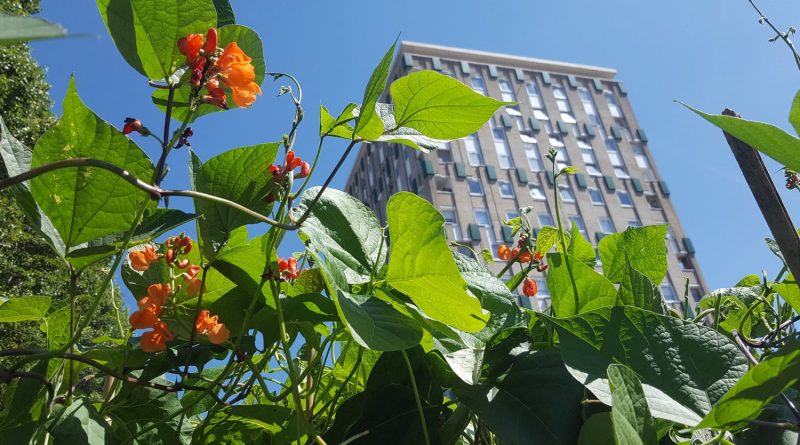Move to East London to become a gardener
Environment correspondent Lizzy Mace lives in Globe Town, is Chair of Cranbrook Community Food Garden, and leads the Plastic-free Roman Road campaign. Here she shares the environmental and social value of community food gardens.
We’re well into spring in London now, can you taste it? If you attend one of Roman Road’s local community growing spaces on Big Dig Day this weekend, you literally can!
I never expected to move to East London and become a gardener. But that’s what happened, and it can happen to you too.
When I was looking for somewhere to put down roots in London, I came to view a flat on the Cranbrook Estate, and I noticed a small community garden next to the community centre. Bursting with all kinds of life – plant, animal, insect, human – this tiny patch of land made the decision for me. After moving in, one of the first things I did was contact the garden committee via the phone number pinned to the fence.
Branching out
There are so many pockets of green around East London. Along Roman Road alone there’s Globe Community Garden, Poets’ Corner, Approach Gardens, Cranbrook Community Food Garden, Butley Court Orchard, and the Suffragette Kitchen Herb Garden launched last year, to name just a few.
And with Rocky Park (on the Hollybush estate), Parkside Community Garden, the Canalside Community Garden and the Nomadic Gardens also within walking distance, we’re surrounded by urban food-growing spaces in our little corner of the city.
Each one tucked away off the main streets, you’d have no idea they were there if you weren’t part of that network. In fact, we often have people walking past the garden and commenting that they’ve lived here for decades and never realised it was there until taking a detour through the estate that day.
That’s where open days such as Big Dig Day come in – when food growing spaces open their gates to visitors and potential volunteers at the start of the main growing season, to prepare beds, plant seedlings, chat, laugh and share.
Integrating nature into the city
What does community food growing have to do with the environment? Our food system is broken. The way we grow, produce, package, transport, prepare and then dispose of our food is destroying our ability to live on the planet and continue feeding ourselves in future. Growing food locally is a huge part of the solution.
Providing city-dwellers with opportunities to experience nature could help generate an essential shift in the way we see our place in the world. Much of the current climate and ecological crises we face can be traced back to a belief that humans are somehow separate from or superior to nature.
Bringing ourselves back from the brink requires us all to recognise that we are part of nature and nature is part of us. In the cities this attitude of separation is especially obvious and deeply ingrained. Nature is seen as something to be controlled and submitted to our will – ‘weeds’ are sprayed as a matter of routine with chemicals that have a knock-on effect on insect populations and public health.
Wild areas are tarmacked over, paved, or earmarked for development, such as the Limehouse Triangle – now under threat even after the council’s declaration of a climate emergency just last month. Trees are netted over to prevent birds from nesting so that development can take place.
Community gardens, in staking a claim for humans and nature to exist together within the city, are making a defiant political statement of their own simply by existing.
Moving from a global to a local system
In our globalised food industry, food distribution relies heavily on fossil fuels, while in contrast small local food growing projects are largely low emitters of carbon. They are not dependent on food travelling hundreds or thousands of miles. An added bonus to this is the lack of packaging required when picking food directly from your local garden.
Turning to methods that encourage a variety of plants within one space – known as ‘polyculture’ and including permaculture, agroforestry and eco-agriculture – makes our food more resilient both to changing weather and to pests. More and more community growing spaces and small urban farms are turning to these methods where the bigger companies that dominate the food markets are slower to change.
And just as I was struck by the essential creativity – both human and non-human – that Cranbrook’s community garden teemed with when I first glimpsed it through my window, if we can start to embrace the messy, abundant, unpredictable creativity of nature and favour those thriving spaces over a neat and tidy lawn, perhaps we’ll even learn to embrace our own messy, abundant, creativity as well. Creativity that we will need to transform the systems we live by, into ones that not only protect life, but allow it to thrive in all its forms.

